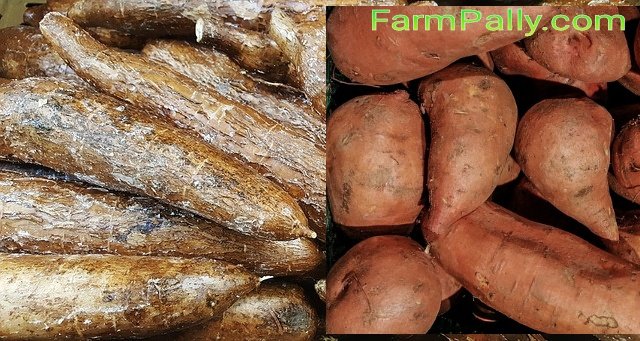Pigs are omnivorous animals and they can eat most foods that humans eat.
Whether you’re raising pigs commercially or as a pet, you can feed your pigs with homemade foods.
Some of the ingredients for making pig feed are also eaten by man.
If you’re trying to minimize feed costs and feed your swine cheaply, then these tuber foods can help.
Roots and tubers are commonly utilized as a substitute for cereal grains in feeding swine.
Compared to cereal grains, they are relatively low in crude protein, minerals, and vitamins and have high moisture content, which makes storage difficult.
However, the starch of the roots and tubers is highly digestible and they eat it naturally when they are on free range.
Some of the human foods that are not toxic to pigs are the following.
Cassava
Cassava roots can be fed to animals in different forms. It is always advisable to have them processed before being included in pigs’ rations.
This has become important as fresh cassava tubers are high in hydrogen cyanide, which has been known to be poisonous to animals, including pigs.
Even humans can not eat fresh cassava tubers. therefore, it should be processed into silage.
Dried cassava or cassava roots can be used to replace a substantial part of maize in the diets of pigs.
Apart from the roots, the leaves can be used in the form of leaf meal as a protein source in livestock rations.
The cassava peel can also be dried, milled, and added to pigs’ feed.
While feeding pigs with whole cassava is possible, it’s not encouraged. It does not make a high-quality feed unless it’s supplemented with other ingredients of pig feeds.
The use of cassava in feeding pigs at levels higher than 50% usually results in a decrease in both live weight and feed conversion efficiency.
It is, therefore, suggested that supplementation with methionine at a level up to 0.2% should be practiced.
Supplementation with palm oil and glucose has been known to result in an increase in daily weight gain and feed conversion efficiency.
Palm oil addiction enables the effective use of methionine in the diet.
The use of hydrocyanic acid content of the cassava by the formation of gluconohydrin thereby resulting in improved palatability which results in increased feed intake.
Sweet Potato Vine
People often ask if swine can eat sweet potato. Of course, they can, it may be useful feed material for feeding pigs.
Sweet potato as silage is used when there’s a short supply of feed.
The stems and leaves could be used as sources of forage. The crude protein of sweet potato is around 5% and it’s higher than that of cassava.
It has similarities with cassava in the sense that it is relatively low in minerals and vitamins.
Only a low amount of it should be used in your homemade pig feed formulation for commercial purposes.
Unlike cassava, fresh tubers are poorly digested by animals, therefore, it should be discouraged in making fast-growing pig feeds
This is because of its poor digestion which may result in problems like flatulence and diarrhea.
Yam
Yam is a highly desired food material by man and is not commonly used in animal feeding except under experimental conditions.
The peels, however, when cooked may be used to feed pigs, especially under extensive rearing systems.
The starch of yam is well digested with a crude protein content of about 2% on a dry matter basis.
Cocoyam
It is also widely used as food by man and its use as feed for an animal is uncommon.
Its chemical composition and nutritive value are similar to that of yam.
Banana Fruit
This could be a useful food material mainly in pig diets, usually as a fresh or ensiled product.
The starch of green or unripe bananas is poorly digested. Cooking and ensiling are processing procedures that can improve digestibility.
Conclusion
Pigs can eat most foods that humans eat. However, while some of these foods are low in the main feed ingredients for the healthy growth of swine, some can be toxic if not processed and made edible for pigs.
Root and tuber foods are not the best substitutions for pig feed formulation but can help to reduce cost, and should be supplemented with quality pig feed nutrients.








